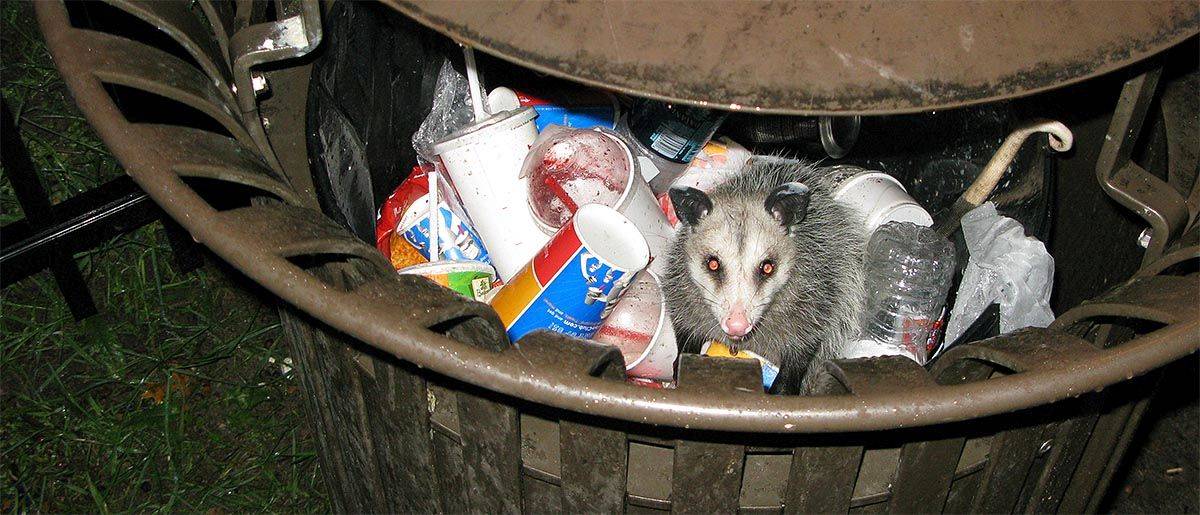We’re “industrialized” humans. We know we waste a lot. We know that with every purchase, we are somehow, on some level, contributing to the expansion of a landfill at home or overseas. But oftentimes, we’re not considering how immediate the consequences are, and how our actions affect other species. At least, not until we find a critter nibbling away at our leftovers.
This issue is apparent along the walkways of the University of Illinois. The stone concealed garbage cans, usually emptied early in the morning before classes begin, are improperly designed and pose a threat to local wildlife.
Though they seem like standard containers, the inner rims have declining slopes, so that garbage can just slide in. However, the material it’s made out of is metal, and the surface is pretty flat and slick. So, when a squirrel or another animal with paws and claws falls in, though it may be able to jump and climb, it’s still much more difficult for it to clamber out.
Take, for example, last winter, when a police officer was called after an opossum was reported to be trapped in one of the receptacles in the front of ACES Library. In order to try and free the creature, the officer tipped the can over, and simply stood back to wait, hoping it would leave of its own volition (which it eventually did). In passing the scene to the door, I noticed it cringing behind food wrappers, its eyes glinting in the lamppost light, likely wondering what the big deal was.
The problem here is that the animal needed some kind of outside assistance. Granted, scavengers are scavengers. Raccoons and rats and others always find a way into our trash, and shenanigans ensue. But what would have happened if no one had noticed? If a public service official just went about disposing the trash as usual, not expecting anything but recyclable materials, half-eaten food, and gum?
Designs like this endanger everyone. They put workers at risk to be bitten or attacked by animals who accidentally get themselves stuck (or decide the bottom of a rank can is a cozy spot to chill), and they put scared animals at risk for being hurt by workers when both human and non-human parties are only defending themselves.
But perhaps, despite the trash cans being ridiculously shaped, the real dilemma is that we don’t sort and separate our waste efficiently. When an animal is digging through garbage, it’s not exactly to find material for its home (though, I once did see a squirrel carrying a granola wrapper up to its nest). Usually, it’s to find our scraps. Scraps that could be easily composted and used for fertilizer and thus aid in decreasing the occurrence of those aforementioned situations.
Champaign-Urbana is surrounded by farms, prairies, gardens, and greenhouses. Given the high amount of dormitories producing large quantities of food which frequently go uneaten and untouched because of health codes, compounded with the everyday waste of businesses and people across both cities, why hasn’t this system been thoroughly harnessed? There are serious benefits to composting, whether it be to enrich the land, help prevent soil erosion, or utilize the matter as a natural pesticide.
It just doesn’t make sense anymore not to separate organic material from plastics and other items. It’s an exorbitant waste of money, especially considering how easy it would be to manipulate our squandered stuff for an eco-friendly function.
Sure, it’s less complicated to not employ people to tend to the composting process and distribution. It’s lazy not to lobby for an ordinance that would mandate the recycling of organic material. It’s lazy to shrug and say, “Well, it’s not my responsibility.”
But the costs are too high now to ignore our impact. Police officers should be out patrolling and responding to serious emergencies, not standing by a garbage can for however-long-it-takes for an opossum to crawl out. It isn’t enough to invest in shopping at local markets and food co-ops and helping small farms survive financially. We should be making the most out of everything we use, and strive for a closed system. That’s the logical and simple answer.
And other people seem to recognize this as well. Last year, the university began experimenting with using utensils and plates made from compostable material, and specifically in ISR (at the beginning of 2013), food waste was separated from the dishes. But it was not a lasting change, despite the university’s very public “compost” initiative which claimed the following:
The University of Illinois at Urbana-Champaign is pursuing development of a large-scale food waste composting facility on the University’s property, in order to compost food waste from University dining halls. This interest is precipitated by the commitment made by the University in the 2010 Illinois Climate Action Plan (iCAP): “The University will commit to… a large‐scale food composting project by 2012.”
Well, it’s 2014 now. The university and the Center for a Sustainable Environment are clearly behind. It’s been admitted, also, that much of the food waste is still being diverted to a landfill. My question is: why? And why allow the project to get behind when there are so many immediate uses? Take, for example, the Randolph Street Community Garden, the Arboretum, greenhouses near the National Soybean Research Center and INHS building, the grounds around Japan House, all the parks and common fields between both cities. Not to mention individuals who would use compost as fertilizer for their own plants.
Could this be another one of the university’s ploys? To fund and begin a project for the sake of positive publicity, only to leave it underdeveloped? This has happened before, particularly with the Inclusive Illinois Initiative on the subject of “Diversity”, which this past year has seen serious criticism for failing to represent and accommodate for gender identity and orientation diversity as equally as ethnic, cultural, and religious diversity on campus.
But I digress.
In all sincerity though, something must be done. Soon.








